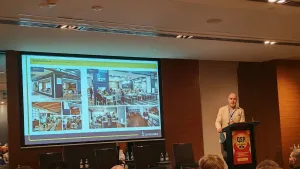
Doshii believes in-venue digital ordering will gain popularity over time
Chief commercial officer Josh Franklin explains to QSR Media how integration will continue to assist the hospitality industry beyond the pandemic.
The food delivery boom, furthered by the pandemic, resulted in a multitude of platforms of apps that customers can use to get their orders.
Cloud platform Doshii looks to help chains focus on kitchen efficiency by syncing such information platforms and apps into partnered POS systems. This, according to them, results in operational efficiency, reducing labour cost involved with rekeying orders, and minimising mistakes that lead to product wastage and unhappy customers.
Speaking to QSR Media, chief commercial Officer Josh Franklin explained how integration will continue to assist the hospitality industry beyond the
pandemic.
QSR Media: The pandemic delivery boom made a case for businesses to streamline how they handle third-party ordering apps. How are chains utilising the synced insights and data from Doshii?
Franklin: With Doshii, chains are able to clearly understand which channels are driving the most revenue and profitability to them, for example in-venue ordering habits versus pick-up or kiosk and device orders. They can then optimise those channels’ offerings.
They can also look at less successful channels and assess how their results can be improved. They can see what is selling best and when, and look at modifying the menu accordingly or instigating other sales and promotional activity. Doshii also provides unique and tailored insights for each store. This means that menus and channels can be optimised, to ensure sales are being maximised for each location.
Doshii has a full menu management system to allow operators to manage their menus from a central platform. All styles of operator will benefit from less time managing menus across multiple apps. They’ll also be able to avoid costs incurred through rekeying orders into the POS, and removes human error associated with missed or incorrectly rekeyed orders. Ultimately it will improve revenue, reduce operational costs and increase efficiency.
What has the delivery data been telling you about QSR customers?
Our experiences from the past 12 months have shown that ordering from apps - in venue, at home or on the road - is surging; customers spend up to 30 per cent more when they order from their devices.
Another trend we’ve seen emerge is that once consumers have ordered from their device the first time, they are far more likely to want to do it again.
Some areas of the Australian hospitality industry, including on-site dining, were badly hit during the pandemic. As a result, we’ve seen venues looking for unique ways to offer delivery, pick-up and app-based ordering to attract and retain customers.
Food delivery services thrived through the lockdown. There was a massive demand from customers wanting to pay for their meals with credit cards or some form of mobile or contactless payment. We also found customers preferred to order from a digital menu on their phones, even if they chose to collect the order themselves. This was, in part, due to adhering to COVID-safe rules, but this type of mobile ordering and payment preference hasn’t changed, even with the easing of restrictions.
What’s your take on what’s now happening in the industry? Any predictions on where it will go?
As restrictions ease considerably across Australia, we’ll continue to see a strong demand for food delivery services among consumers. We believe that in-venue digital ordering, while in its infancy here in Australia, will be a trend that will continue to gain popularity over time.
We’ll also see new apps in the marketplace that will harness artificial intelligence capabilities, making them more intuitive. They’ll offer consumers greater customisation and preferences in their choice of menu options and ‘healthy’ food items.
How has take-up differed between chain stores and smaller independent businesses?
It’s been rewarding to see the benefits for both styles of business. Many of the smaller, independent outlets and businesses have needed Doshii simply to be able to operate efficiently and to ‘tech up’. We’ve helped hamburger stores, for example, that may have previously been predominantly cash businesses with no delivery partners be able to quickly open up these new channels, streamline their business, and keep them focussed on making and serving good food.
We’ve helped franchised stores tap into their unique markets in a way that wasn’t previously possible. While they have the advantage of having processes and procedures in place, they’ve managed to save money, time and effort with our data insights that lead to less wastage and the ability to maximise and tailor their offering across their different channels. Integration means running business smarter and gives operators the opportunity to capitalise on accurate and insightful data.
What does this mean for consumers?
Happier customers lead to a more vibrant hospitality industry. We think giving customers more of what they want, streamlining the ordering process and minimising any opportunity for order errors will provide a more fulfilling experience all ‘round. In turn that will lead to return business and glowing reviews and ratings for the venue operator. It’s a win-win for everyone involved.
























